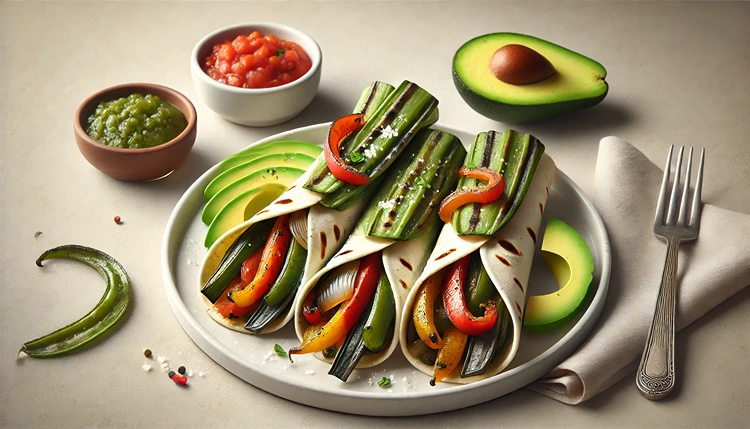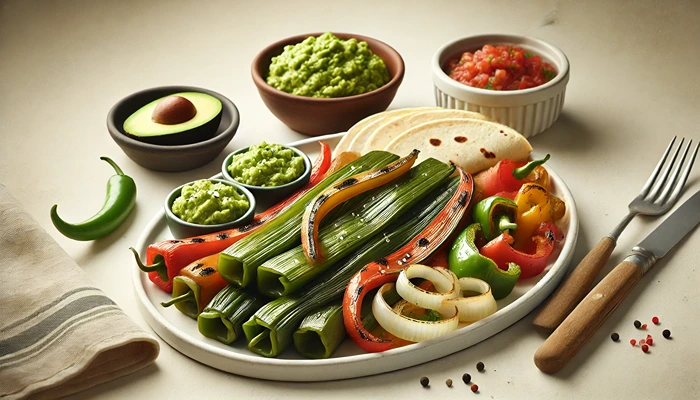Nopales cactus has been a staple in Mexican cuisine for centuries, dating back to the Aztec era. Its versatility, nutritional value, and unique texture have made it an enduring favorite in traditional dishes. But did you know it’s still a beloved ingredient in modern recipes? Whether you’re a fan of ancient cooking methods or looking for something fresh and trendy, this article is here to explore how the humble nopales cactus can elevate your culinary game.
What Are Nopales?
Nopales, also known as prickly pear cactus pads, are a signature ingredient in Mexican cuisine. These fleshy pads come from the Opuntia cactus and are often harvested while still young and tender. They have a slightly tart, earthy flavor and a texture that can be compared to green beans or okra when cooked. Nopales are prized not just for their taste but also for their health benefits, as they are rich in vitamins, antioxidants, and fiber.
Why Did the Aztecs Love Nopales?
The Aztecs were known for their use of indigenous plants and vegetables, and nopales were no exception. This resilient plant grows well in the arid regions of Mexico, making it an ideal food source. The Aztecs used nopales in various ways: grilled, boiled, or chopped into stews. Their love for nopales wasn’t just about availability—it was also due to the cactus’s medicinal properties. Nopales were believed to help with digestion, inflammation, and blood sugar regulation, which are benefits still recognized today.
Helpful Hint:
When selecting nopales, look for bright green pads that are firm yet slightly flexible. Avoid pads that appear wrinkled or have brown spots, as they might be past their prime.
Traditional Nopales Dishes from the Aztec Era
Many of the traditional recipes using nopales date back to the time of the Aztecs. These dishes were simple, focused on using ingredients available in the region. Here are a few examples of how nopales were integrated into Aztec meals.
Nopales with Maize
One of the most common ways the Aztecs prepared nopales was by cooking them with maize, the cornerstone of their diet. The combination of these two ingredients created a nutritious, filling meal that could be eaten throughout the day. The nopales added a unique tang and texture to the dish, while maize provided carbohydrates for energy.
Nopales in Stews
Stews were another popular way the Aztecs consumed nopales. They would combine the cactus with tomatoes, chiles, and beans to create hearty, flavorful meals. These stews were not only delicious but also packed with nutrients, making them ideal for sustaining the hardworking Aztec people.
How to Prepare Nopales for Cooking
If you’re new to cooking with nopales, the preparation might seem intimidating. But with a few simple steps, you’ll be ready to enjoy this nutrient-rich plant in your own kitchen.
- Step 1: Begin by removing the spines. Most nopales sold in stores come with the spines already removed, but it’s always good to check for any stragglers.
- Step 2: Rinse the nopales under cold water to remove any sticky residue.
- Step 3: Chop the nopales into small strips or cubes, depending on the dish you’re making.
- Step 4: Boil or sauté the nopales to reduce their slimy texture, similar to how you would prepare okra. Cooking them for about 10-15 minutes is usually enough.
Once you’ve prepped your nopales, you can add them to salads, tacos, or even scrambled tofu for a protein-packed breakfast.
Nopales Cactus in Modern Mexican Dishes
Nopales aren’t just a relic of the past—they are still widely used in modern Mexican cuisine. Today, they are a common ingredient in tacos, soups, and salads, providing a unique, slightly tangy flavor that complements other traditional ingredients. Let’s explore some contemporary dishes that showcase nopales in new and exciting ways.
Grilled Nopales Tacos
Grilling nopales is a fantastic way to enhance their flavor. When placed on a hot grill, the cactus pads get slightly charred, which brings out a smoky depth. Topped with your favorite salsa, avocado, and beans, grilled nopales tacos are a healthy, vegan-friendly option that’s perfect for summer barbecues.
Grilled Nopales Tacos
Ingredients
- 4 nopales cactus pads
- 2 tablespoons olive oil
- 1 teaspoon sea salt
- 1 teaspoon black pepper
- 8 small corn tortillas
- Your favorite salsa
- 1 avocado, sliced
- 1 cup black beans, cooked
Instructions
- Preheat your grill to medium-high heat.
- Brush the nopales with olive oil and season with salt and pepper.
- Grill the nopales for 5-7 minutes on each side until lightly charred.
- Remove from the grill and slice into strips.
- Warm the corn tortillas on the grill for 30 seconds on each side.
- Assemble the tacos by adding grilled nopales, black beans, avocado slices, and salsa.
Notes
For an added kick, sprinkle some lime juice over the tacos before serving.
Can You Eat Nopales Raw?
Yes! While nopales are often cooked, they can be eaten raw as well. When served fresh, nopales have a crisp texture similar to that of a green pepper. Raw nopales are usually sliced thinly and added to salads, where their slightly tart flavor pairs well with citrusy dressings and other fresh veggies.
Helpful Hint:
For a refreshing salad, toss raw nopales with tomatoes, onions, cilantro, and a squeeze of lime juice. Let the salad sit for 10 minutes to allow the flavors to blend before serving.
Health Benefits of Nopales
Beyond their culinary uses, nopales are celebrated for their impressive health benefits. They’re packed with antioxidants, vitamins, and minerals that can help boost your immune system, lower cholesterol, and even aid in weight management. Nopales are also known for their high fiber content, which supports healthy digestion and helps regulate blood sugar levels—perfect for those managing diabetes or looking for a low-carb ingredient.
“Nopales cactus is not just a versatile culinary ingredient, but a powerhouse of nutrition, offering benefits for heart health, blood sugar regulation, and digestive wellness.”
Health Benefits of Nopales
| Benefit | Explanation |
|---|---|
| Regulates Blood Sugar | Nopales contain a high amount of fiber, which helps slow down sugar absorption in the bloodstream, making them ideal for those managing diabetes. |
| Supports Digestion | The fiber in nopales promotes healthy digestion and prevents constipation, ensuring smooth bowel movements. |
| Rich in Antioxidants | Nopales are packed with antioxidants like flavonoids, which help neutralize harmful free radicals in the body. |
| Boosts Immune System | With high levels of vitamins A and C, nopales help strengthen the immune system and fight off infections. |
| Reduces Inflammation | Nopales have anti-inflammatory properties, which can help reduce swelling and pain, especially for people with arthritis or joint issues. |
Modern-Day Uses of Nopales Cactus
Today, nopales cactus has evolved from its traditional roots into a staple in contemporary Mexican cooking. It’s also gaining popularity in plant-based diets across the globe. With its mild flavor and dense nutritional profile, chefs are incorporating nopales into various dishes that blend the old and new in exciting ways. Let’s look at some modern recipes where nopales shine.
Nopales Stir-Fry
Believe it or not, nopales can fit right into your favorite stir-fry dishes. The slight tartness of the cactus pads adds a refreshing twist to the rich, savory flavors often found in stir-fries. Paired with tofu or tempeh, bell peppers, and soy sauce, nopales are an unexpected yet delightful addition to this quick and healthy meal.
Nopales Smoothies
Nopales in a smoothie? Yes, it works! Adding a small amount of raw nopales to your morning green smoothie not only boosts the fiber content but also adds a subtle tartness that balances out the sweetness of fruits like pineapple or mango. This is an excellent way to sneak in extra nutrients without overpowering the flavor of your smoothie.
Pickled Nopales
Pickling nopales is a common method of preservation that transforms their flavor into something tangy and slightly spicy, depending on the pickling solution used. Pickled nopales can be added to tacos, sandwiches, or eaten straight from the jar. This method of preparation has deep roots in Mexican cuisine and is still widely practiced today.
Helpful Hint:
To make pickled nopales, blanch the cactus pads for a few minutes, then immerse them in a mixture of vinegar, salt, garlic, and spices. Let them sit in the fridge for at least 24 hours for maximum flavor.
Nopales in Vegan and Plant-Based Diets
Nopales are becoming a popular ingredient in vegan and plant-based diets, thanks to their versatility and nutritional value. They’re a great substitute for meat in tacos, fajitas, and other dishes where you want to add a bit of heartiness without using animal products. The fiber and vitamins found in nopales make them a perfect addition to a balanced, plant-based meal plan.
Vegan Nopales Fajitas

For a vegan take on traditional fajitas, swap out the meat for grilled nopales and sautéed bell peppers. The nopales provide a chewy, meaty texture that holds up well to the bold flavors of cumin, chili powder, and lime. Top with guacamole and pico de gallo, and you’ve got a fajita that’s just as satisfying as the original.
Nopales in Plant-Based Tacos
One of the easiest ways to incorporate nopales into a plant-based diet is by using them in tacos. Simply sauté the cactus pads with onions, garlic, and your favorite spices, then serve in corn tortillas with beans, avocado, and salsa. These nopales tacos are not only delicious but also pack a punch of nutrients.
Vegan Nopales Fajitas

Ingredients
- 4 nopales cactus pads
- 2 bell peppers, sliced
- 1 large onion, sliced
- 2 tablespoons olive oil
- 1 teaspoon cumin
- 1 teaspoon chili powder
- Salt and pepper to taste
- 8 small corn tortillas
- Guacamole and salsa for serving
Instructions
- Heat olive oil in a large skillet over medium heat.
- Add the sliced nopales, bell peppers, and onion, and sauté for 8-10 minutes until tender.
- Season with cumin, chili powder, salt, and pepper.
- Warm the tortillas in a dry skillet, then fill each tortilla with the nopales mixture.
- Top with guacamole and salsa before serving.
Notes
For an extra kick, add some jalapeño slices to the sauté mix or drizzle with hot sauce before serving.
Are Nopales Good for You?
In case you’re wondering, nopales aren’t just tasty—they’re incredibly healthy too. This ancient superfood is low in calories but high in fiber, antioxidants, and vitamins A and C. Nopales are also rich in calcium and magnesium, which contribute to bone health.
Nopales for Blood Sugar Control
Studies suggest that nopales can help regulate blood sugar levels. The high fiber content slows down the absorption of sugar into the bloodstream, making it a great option for people with diabetes or those looking to maintain steady energy levels.
Nopales for Weight Loss
If you’re on a weight loss journey, adding nopales to your diet could be beneficial. Their low-calorie, high-fiber profile helps keep you full longer, reducing the urge to snack between meals. Plus, the vitamins and minerals in nopales support overall health while you’re cutting calories.
Can You Grow Nopales at Home?
Yes, you can! Growing nopales at home is easier than you might think. If you live in a warm, dry climate, the nopales cactus can thrive in your backyard or even in a container on your patio.
How to Plant and Care for Nopales
- Choose a sunny spot with well-drained soil.
- Plant a cactus pad by placing it horizontally in the soil, covering about one-third of the pad.
- Water the cactus sparingly, allowing the soil to dry out between watering sessions.
- Within a few weeks, the pad will begin to root and grow new pads.
Once your nopales cactus is established, it requires minimal maintenance and can provide a fresh supply of nopales year-round.
FAQs
Wrapping Up
Nopales cactus offers a delicious and nutritious link between ancient Aztec culinary traditions and modern-day dishes. Whether you’re experimenting with grilled nopales tacos or adding them to your vegan fajitas, there are countless ways to enjoy this versatile plant. Rich in fiber, antioxidants, and essential vitamins, nopales bring both health benefits and unique flavors to the table. As more people discover the joy of cooking with this time-honored ingredient, it’s clear that nopales remain an important part of Mexican cuisine—past, present, and future. So, next time you’re looking to try something new, why not add a little cactus to your plate?








